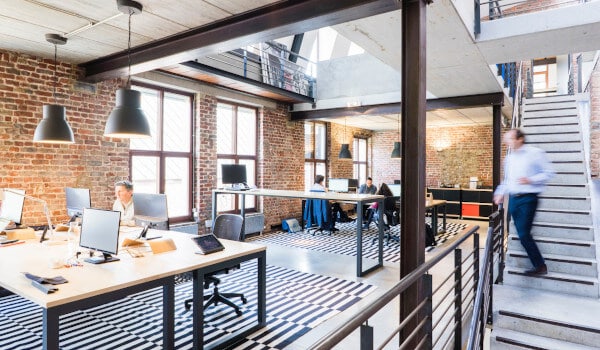
Standing desks in the workplace are hugely popular! And if there’s one thing workplace research can agree on, it’s that too much sitting is bad for you. But there’s a solution for office workers!
Numerous studies have shown that switching between sitting, walking, and standing desks in the workplace is vital to your health. Some evidence also suggests that staying active during the workday can improve your mood and mind.
Naturally, these benefits help employers, too. Studies have found that standing desks in the workplace can increase productivity, job satisfaction, and workplace communication.
If you’re thinking about adding stand-up desks to your facility, but you need a little more information to justify the investment, here are 7 fascinating benefits of using standing desks in the workplace. We’ve also included a few strategies for integrating standing desks on a 1:1 or shared basis at the end of this post.
Before we dive in, though, let’s clarify what makes a standing desk, well… a standing desk.

What is a standing desk in the workplace?
Also known as “adjustable workstations” or “stand-up desks,” standing desks do exactly what they state on the label—they allow you to work at your desk while standing up, rather than sitting in a chair.
In theory you could make a standing desk in the workplace by balancing your computer and keyboard on a carefully constructed pile of books. Thankfully standing desks are available in a seemingly endless range of prices and sizes, so you can avoid any homemade desk disasters.
On the cheaper end of the scale, portable stands can be used to convert any fixed desk into a standing workstation. Big retailers like IKEA have been selling mid-range sit/stand desks for years. And custom-built standing desks can be tailored to the user’s needs, usually for a much higher price tag.
Not to be confused with standing desks, “active workstations” take the health benefits a few steps further; in addition to a height-adjustable desk, active workstation setups also typically include an ergonomic chair, a floor pad, balancing boards, and any other combination of add-ons aimed at improving the user’s health.

The benefits of using standing desks
Standing desks have soared in popularity in recent years, likely because science has proven the benefits of adjustable workstations time and time again.
Here’s a breakdown of the many benefits of using standing desks in the workplace. Happily, the kickbacks are great for employees and employers alike.
Boost productivity and workplace communication
Let’s start with the major benefits that standing desks offer to workers and employers.
In 2018, the Stand Up to Work study found that adjustable desks improved productivity, job satisfaction, and workplace communication. Over the course of one year:
- Participants who used standing desks said they were more active, refreshed, awake, limber and energetic.
- An estimated 61% of participants reported that the standing desk positively improved their health outside the workplace, not just inside the cubicle.
And while mostly anecdotal, the study also found that adjustable workstations “may also have social and mental health benefits concerning job satisfaction, coworker communication, and work efficiency.”
Reduce back pain
In America, the average office worker sits for a shocking 15 hours each day. Research indicates that too much sitting can offset the benefits of exercise. And poor posture while sitting can compress spinal discs and lead to premature disc degeneration.
All of this is bad news for anyone with back pain, one of the most common complaints of workers who sit all day. And it’s the reason why several studies on employees with long-term back pain have attempted to discover if standing desks could help.
In the year-long Stand Up To Work study, 47% of participants with height-adjustable desks reported a significant reduction in upper back, shoulder or neck discomfort.
The Take-a-Stand Project found that reducing time spent sitting by 66 minutes per day reduced upper back and neck pain by 54% and even improved mood after 4 weeks. Most interesting was that removal of the stand-up desks negated all of the observed improvements with just two weeks.
Improve cardiovascular health
Society has been researching the benefits of standing for a long time. In 1953, a study of bus drivers found that participants who stood all day had half the risk of heart disease related deaths compared to those who were seated all day long.
More recently in 2013, a comparison of 18 studies with nearly 800,000 participants came to exactly the same conclusion. Findings linked a sedentary lifestyle to a 90% increase in the risk of cardiovascular mortality and—get this—a 147% increase in the risk of cardiovascular events when compared to an active lifestyle.
In other words, if you want to maintain good cardiovascular health: stand up during the workday.
Lower blood sugar levels
Excessive sedentary time is also linked to a 112% greater risk of type 2 diabetes. Generally speaking, the more your blood sugar levels increase after meals, the worse it is for your health. This is especially true for those with insulin resistance or type 2 diabetes.
A UK-based study of 10 office workers found that standing for 3 hours (180 minutes) after lunch reduced the blood-sugar spike by 43% when compared to sitting for the same amount of time. Both groups took the same amount of steps, indicating that the smaller spike was due to standing rather than additional physical movements around the office.
Another study involving 23 office workers found that alternating between standing and sitting every 30 minutes throughout the workday reduced blood sugar spikes by 11.1% on average.
Improve your memory, boost your mood
Too much sitting and a sedentary lifestyle has also been shown to increase the risk of depression and anxiety. No surprises there, right? What’s interesting is how standing up throughout the workday can improve mood, boost energy, and mitigate this problem.
In 2011, the Take-a-Stand Project researched the impact of using standing desks on 24 office workers. At the end of the 4-week study, participants were asked a series of questions regarding the specific benefits of alternating between sitting and standing positions.
Here’s what the research found:
- Participants using stand-up desks reported less stress and fatigue compared to those who remained seated the entire workday
- 87% of those participants also reported increased vigor and energy throughout the day
- 71% felt more focused
- 66% felt more productive
- Upon returning to their old desks, overall moods reverted to their original levels.
Burn more calories, reduce weight gain
Given that more than 44% of office workers say they have gained weight in their present job, burning more calories while you work at your desk sounds like an ideal solution. Unfortunately, standing desks’ status as a calorie-burning solution is a little contentious.
Until very recently, the logic went like this: when you burn more calories than you take in, you’ll lose weight. Standing burns more calories than sitting. Therefore standing is better than sitting, right?
Proving this, a 2014 study found that an afternoon of standing up while working burned over 170 additional calories when compared to an equal amount of time spent sitting. Over the course of a 5-day work week, that’s over 1000 calories burned as a result of standing while working.
And for a time, office workers everywhere rejoiced.
However, in 2016, a different study called these numbers into question. Researchers went deeper by fitting 74 healthy people with masks that measured oxygen consumption as a reflection of how many calories they burned while doing computer work, watching TV, standing, or walking on a treadmill.
Here’s what they found regarding weight loss as a possible benefit of using a standing desk:
- While sitting, study participants burned 80 calories/hour—about the same as typing or watching TV
- When standing, the number of calories burned was only slightly higher than while sitting—about 88 calories/hour
- Walking burned 210 calories/hour
In other words, standing at your desk for three hours only burns an extra 24 calories when compared to sitting, which is about the same number of calories found in a carrot. Walking for just a half hour during your lunch break, however, could help burn off an extra 100 calories each day.
Even though standing desks aren’t a silver-bullet solution for burning calories during the workday, other benefits still make them a superior alternative to fixed-height sitting desks.
And if weight loss is a huge priority for someone on your team, then a treadmill desk might be better suited to their needs.

How to offer standing desks in your facility
The research is clear. Height-adjustable desks play an important role in workplace design that fosters employee well-being.
If you have the option to give every employee a stand-up desk, perfect! But if budget or space constraints make it impossible to provide stand-up desks for all, there is a middle ground: shared standing desks.
Using a tool like desk booking software in OfficeSpace, you can make any standing desk bookable in advance (hoteling) or bookable on the spot (hot desking). If your workplace is using IoT sensors, you could even set up a neighborhood of standing desks for employees to use on a free addressing basis.
If you’d like to see how OfficeSpace can help you create a workplace that makes your people move, think, and feel a whole lot better, book a demo with our team.
Photo Credits: Pexels, Elevate Digital, Stocksnap, Rebrand Cities




